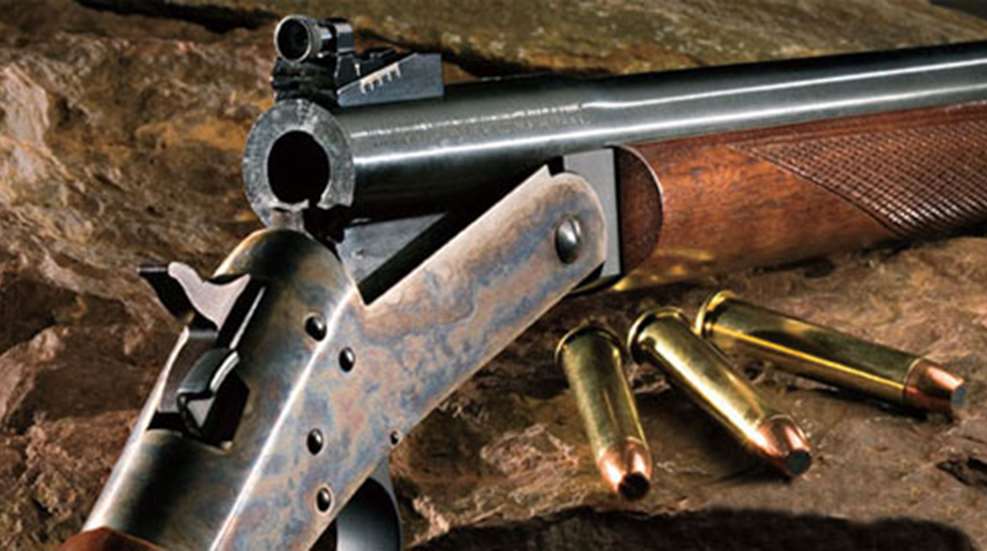
For many decades, hunters across the country—indeed, around the world—have used the economical and simple break-action rifles from Harrington & Richardson (now H&R 1871 and New England Firearms) to harvest everything from squirrels to deer, black bear, elk and moose. As a general rule, the overriding appeal of these arms was their robust, uncomplicated utility. The resurging interest in 19th-century arms in the 1990s brought the H&R single-shots, which were inspired by Frank Wesson’s tip-up rifles of the 1850s, to the attention of Old West aficionados. With such shooters in mind, in 1995, H&R 1871 introduced the Buffalo Classic, a rifle reminiscent of the long-barreled big-bore buffalo guns of the 1800s.
The Buffalo Classic is available only in .45-70 Gov’t and features a medium-weight 32" barrel, adjustable sights and an American black walnut schnabel fore-end and straight buttstock. Nostalgic touches include case coloring on both the receiver and crescent steel buttplate. Locking is accomplished by means of a horizontally sliding locking bolt that engages a bite in the barrel underlug. Depressing a lever just to the right of the hammer retracts the locking bar and allows the barrel to be rotated downward. As the action opens, the automatic ejector snaps rearward, propelling the fired case or live round out of the chamber. There is no active safety on the rifle, but the action includes a transfer bar mechanism that prevents the hammer from contacting the firing pin when the gun is in the hammer-down condition.
The Buffalo Classic’s 32" barrel allows the extraction of all the velocity possible from the .45-70 and provides an extra-long sight radius for more accurate shooting with iron sights. The rear Williams receiver sight with its 0.09"-diameter peep is adjustable for windage and elevation; in the front, a Lyman target globe sight is mounted on the barrel by way of a transverse dovetail. Eight different sight inserts are provided with the front globe.
Note that neither the Williams rear nor Lyman front sight is legal for Cowboy Action Shooting matches sanctioned by the Single-Action Shooting Society. Those wishing to use their Buffalo Classics in such competition must install a tang rear sight and replace the front globe with a more historically accurate post or bead. In its standard factory configuration, the rifle would be suited for hunting and non-SASS target shooting.
We tested the Buffalo Classic at 100 yds. off sandbags using Federal and Winchester loads with 300-gr. jacketed bullets, and a custom load from Garrett Cartridges featuring a 415-gr. hard-cast flat-nose lead bullet. All shooting was done with the rifle’s iron sights rather than a scope, to better simulate how the gun likely would be used in the field or at a match. No malfunctions of any kind were noted during our test-fire session. Accuracy and velocity data are presented in the accompanying table.
The Buffalo Classic’s long barrel produced increased muzzle velocities—as much as 100 f.p.s. higher than nominal published results with the Federal and Winchester loads. The advertised and attained velocities with the Garrett load corresponded almost exactly. Ballistic uniformity was very good, especially with the Federal load, which demonstrated an extreme spread of only 25 f.p.s. Accuracy was excellent, with the Winchester load producing the best average grouping of 1.68" at 100 yds. A front sight insert with a narrow post was used for all test firing. Although potentially not as precise as a front aperture, the post indicated when the gun was being canted, which produced horizontal flyers. The use of a front aperture in combination with a bubble level—and younger eyes than those of our middle-aged test shooter—might produce even better groups. With the rear sight removed, scope mounting is also possible via two threaded holes in the top of the barrel.
Recoil was quite noticeable, especially with the Garrett cast-bullet load, which generated some 2,775 ft.-lbs. of muzzle energy. A firm hold on the gun on the bags reduced barrel jump upon firing, and produced the most consistent groups.
Despite its long barrel, the Buffalo Classic balanced only about 4" forward of the barrel trunnions, and thus it was not excessively muzzle-heavy when fired from either sandbags or an offhand position. The downward-sloping comb put our test shooter’s eye in proper alignment with the sights and did not noticeably slap his face during recoil. At 3¾ lbs., the trigger-pull weight was fine for precise shooting, and its clean, creep-free break made it seem even lighter. The machine-cut, 16-line-per-inch checkering on the wrist and fore-end was reminiscent of 19th century stock work.
There’s not a lot we’d change about the Buffalo Classic. A rubber buttpad might have been preferable to the gun’s steel buttplate, but it would have detracted from the rifle’s authentic look. In sum, the H&R 1871 Buffalo Classic is simple, rugged and gratifyingly accurate, With aftermarket sights, it should be a fine choice for period long-range rifle competition.
Manufacturer: H&R 1871, L.L.C., 60 Industrial Rowe, Gardner,MA 01440; (978) 630-8220; www.hr1871.com
Caliber: .45-70 Gov’t
Action Type: break-action, single-shot center-fire rifle
Receiver: investment-cast ordnance steel
Barrel: 32", medium-heavy contour
Rifling: eight-groove, 1:20" RH twist
Sights: Williams receiver rear sight adjustable for windage and elevation; Lyman front target globe with eight interchangeable inserts
Trigger Pull: two-stage, 3 lbs., 11 ozs.
Stock: American black walnut: length of pull, 14"; drop at heel, 2 5/8"; drop at comb, 1 3/4"
Overall Length: 47"
Weight: 7 lbs., 15 ozs.
Accessories: owner’s manual, warranty card, spare inserts for Lyman front sight
Suggested Retail Price: $449





































